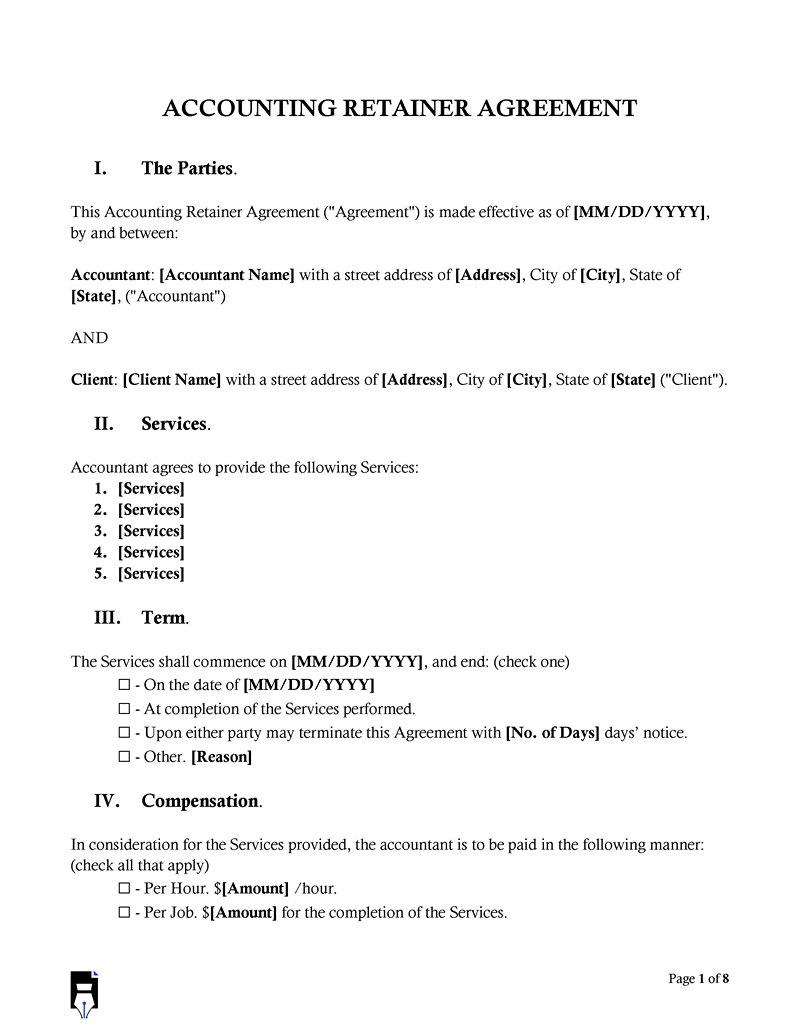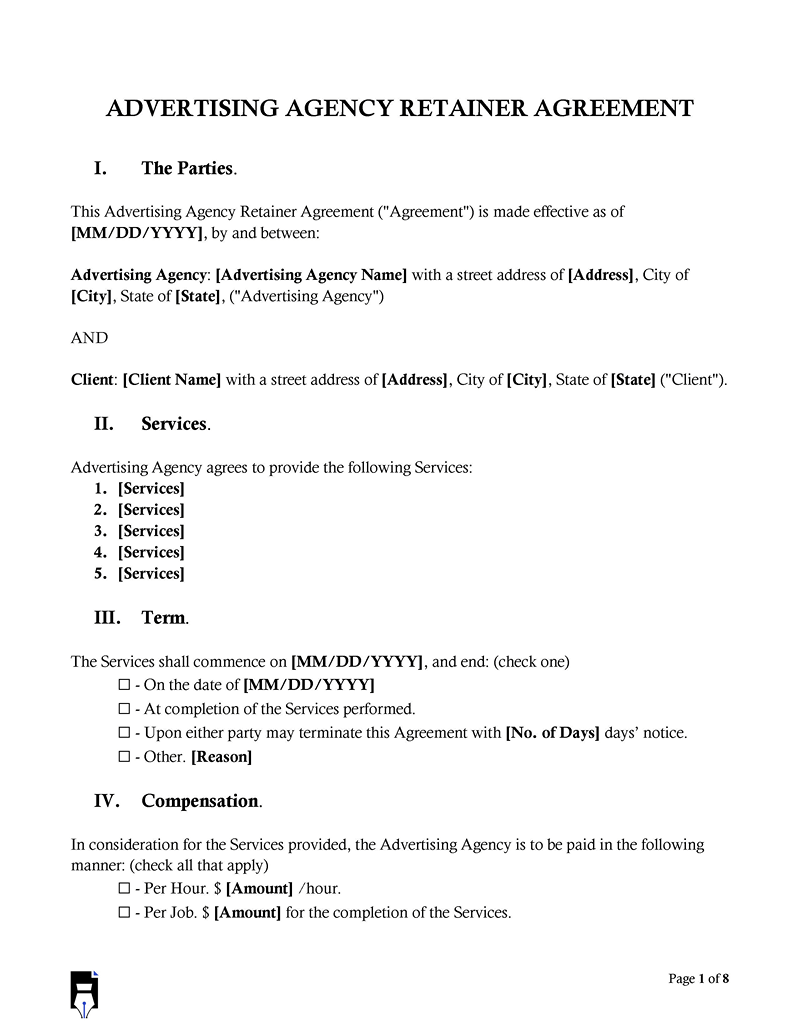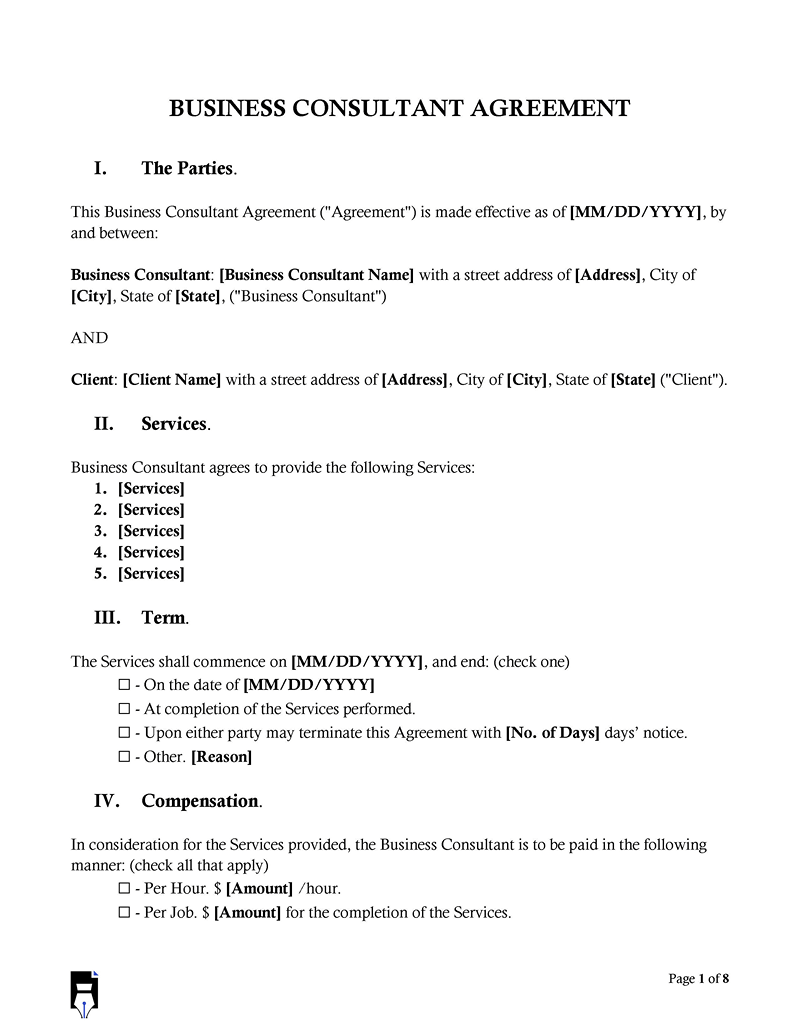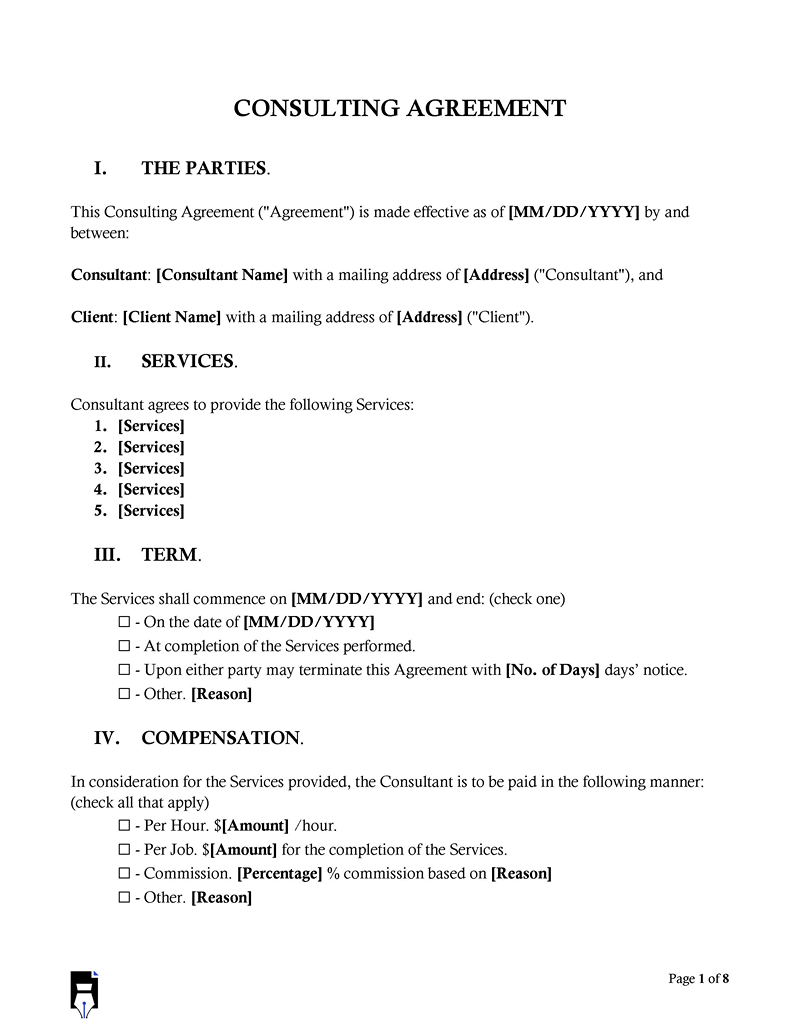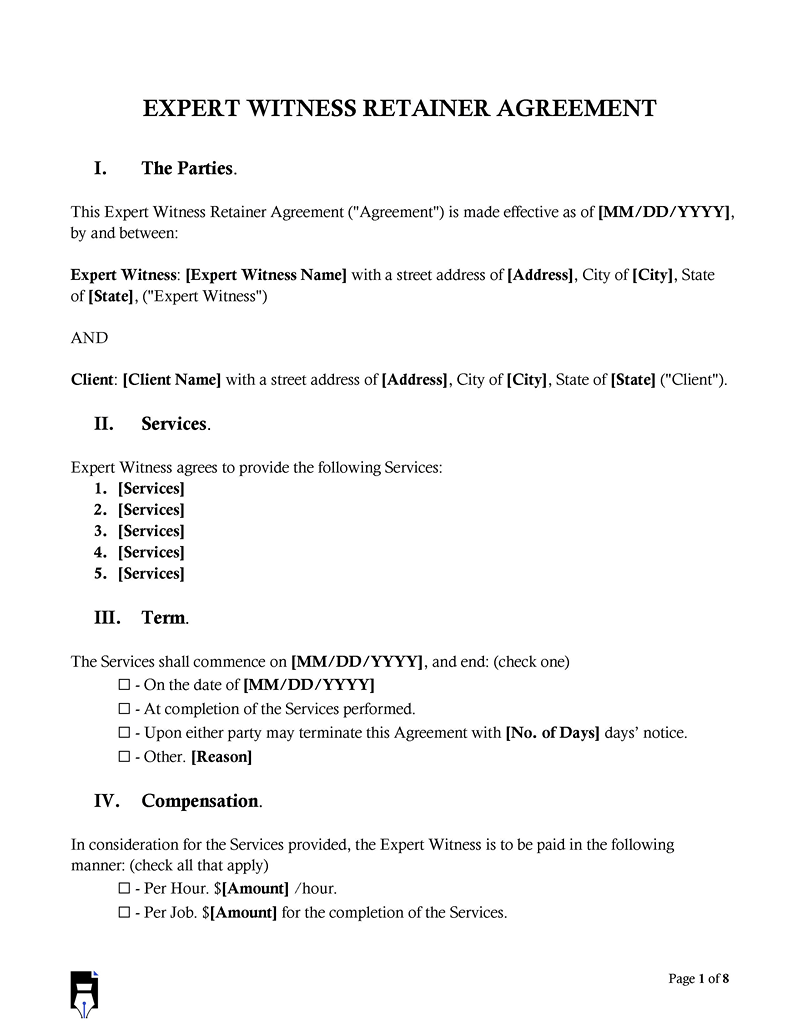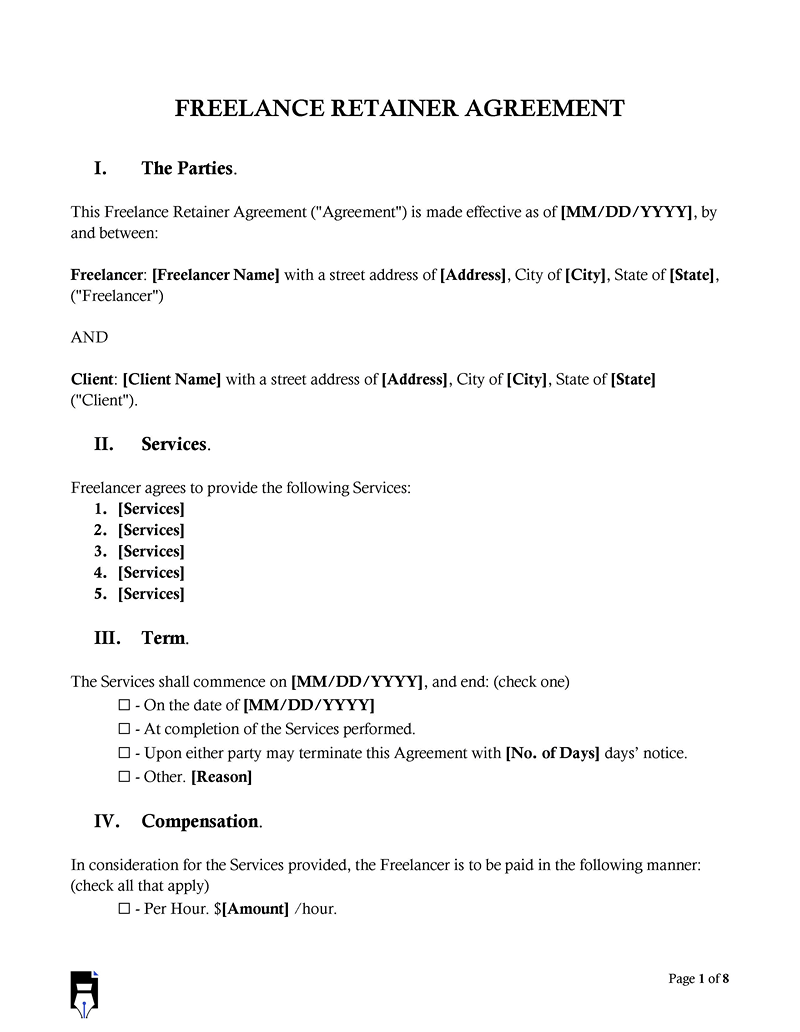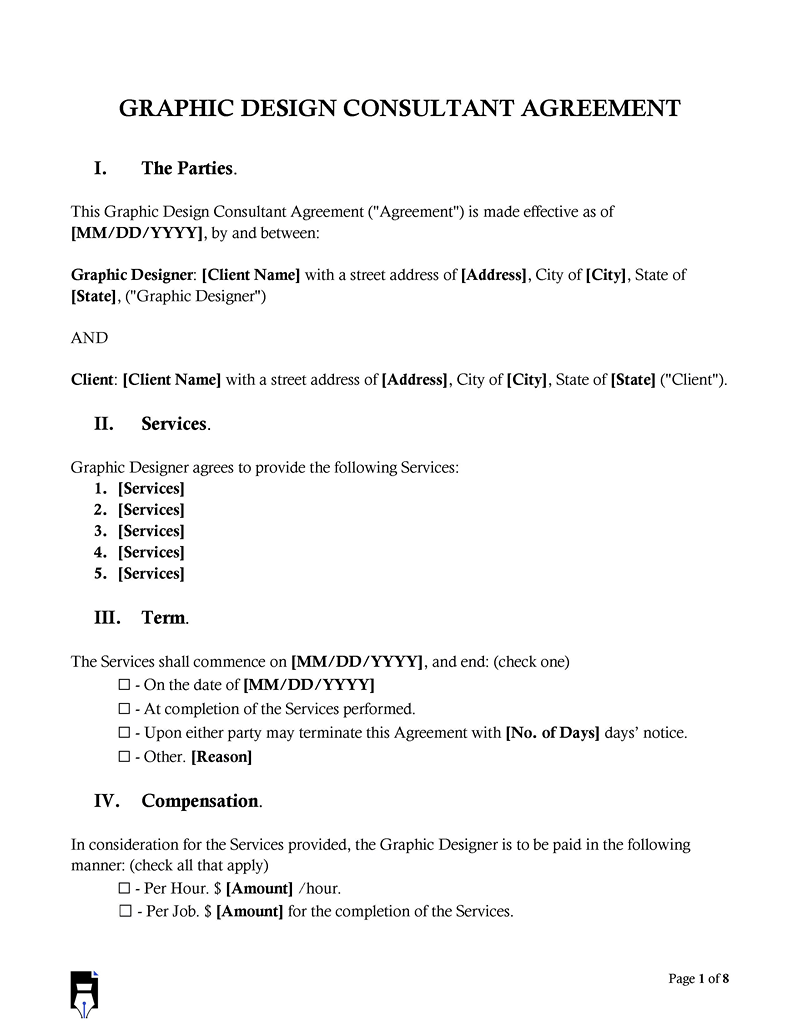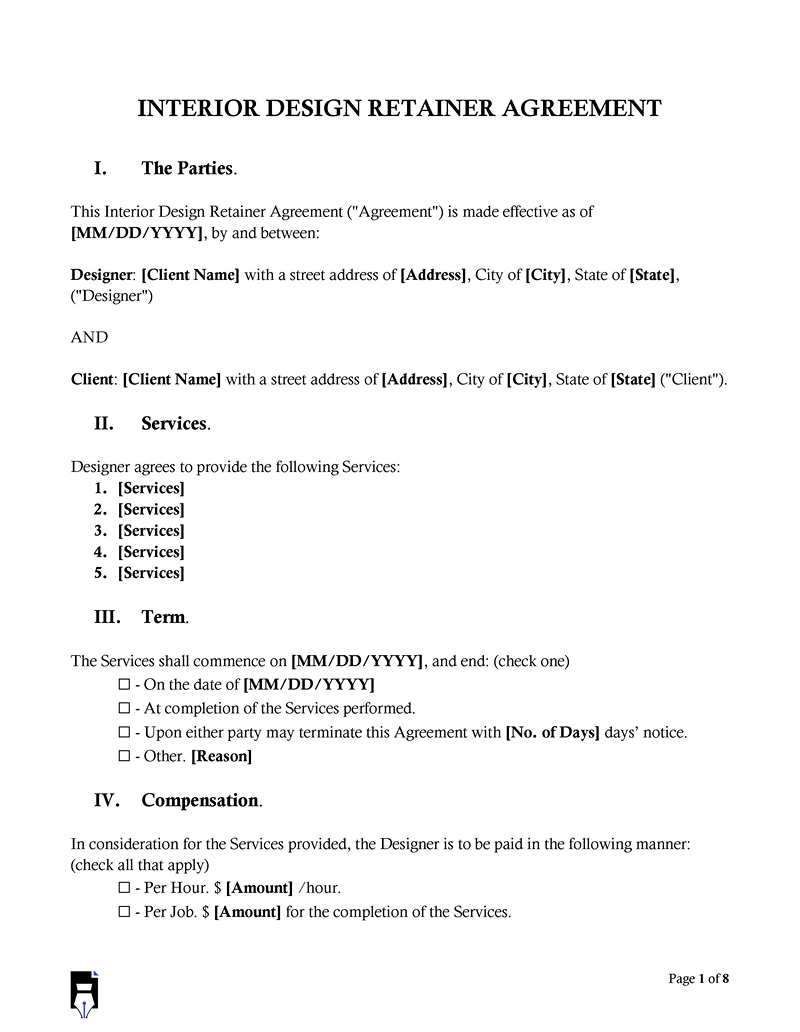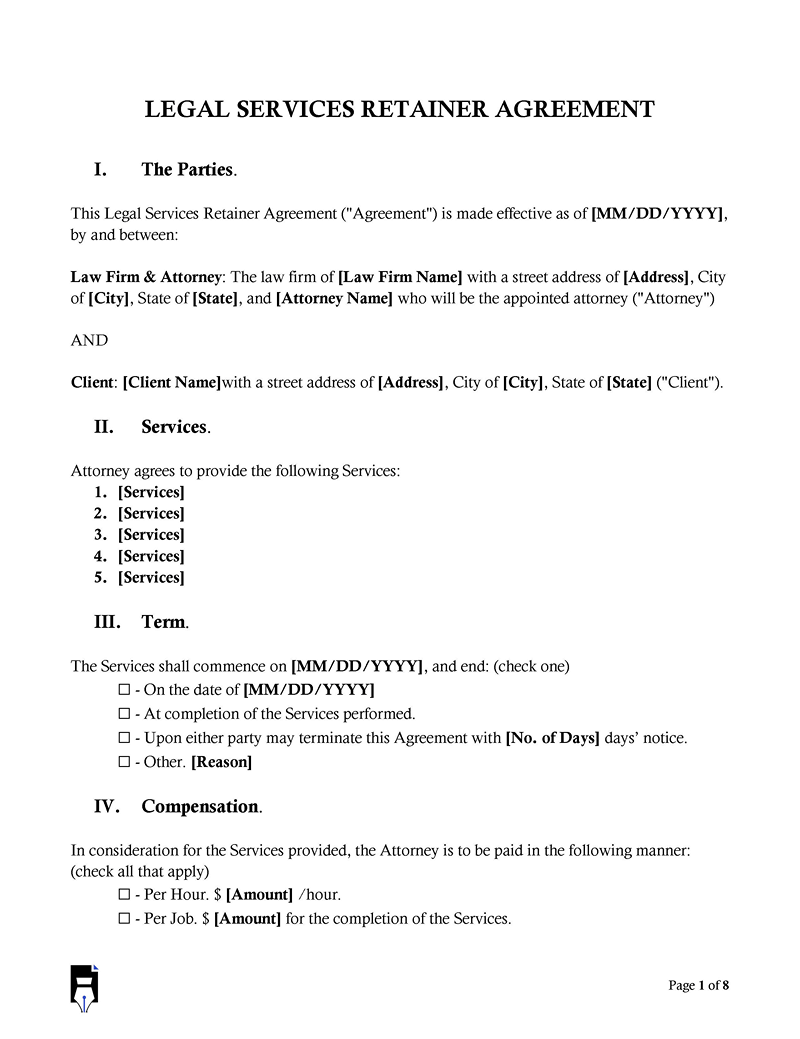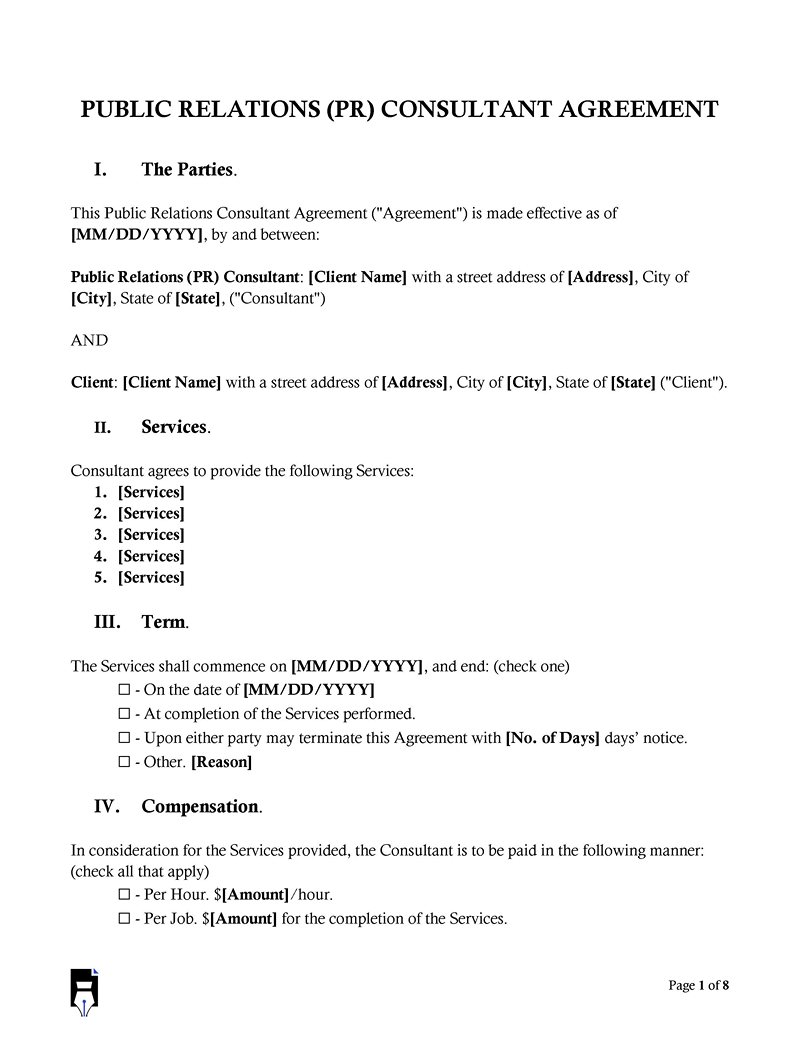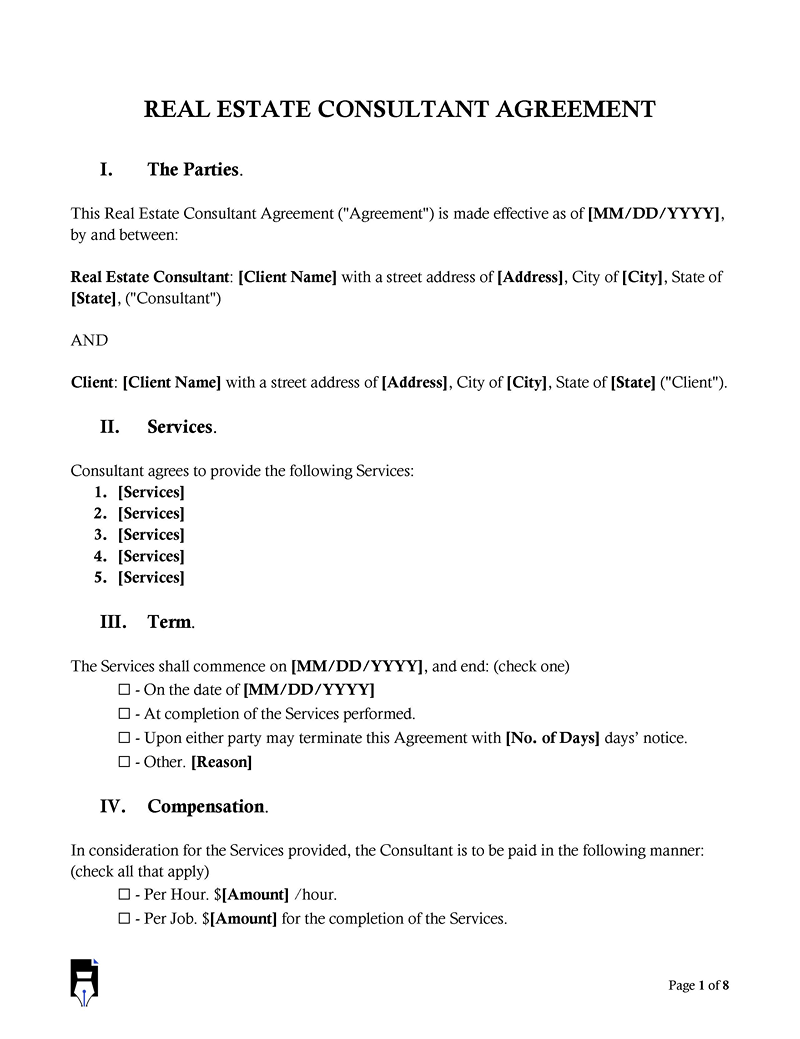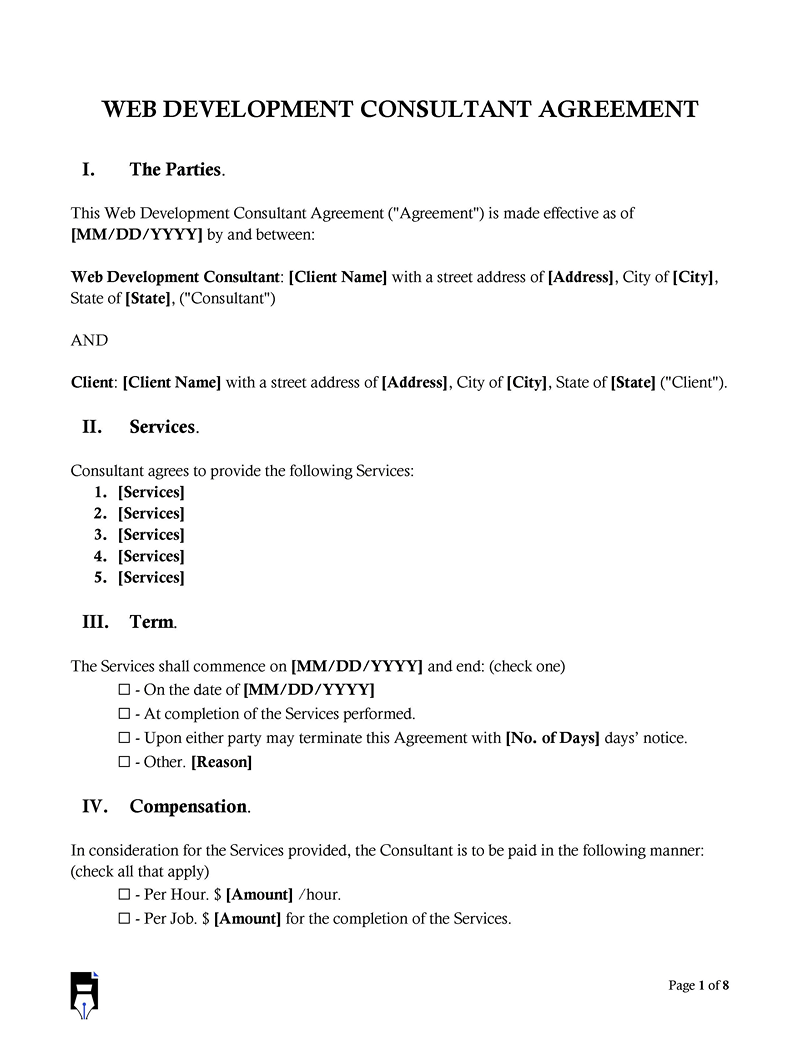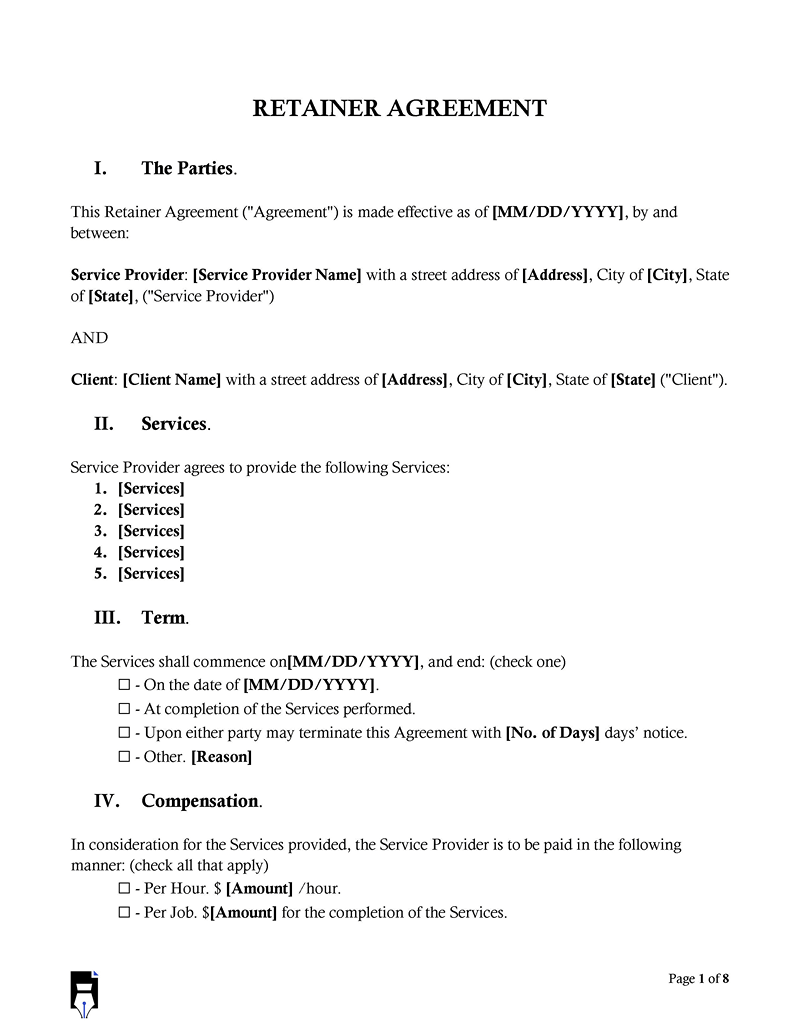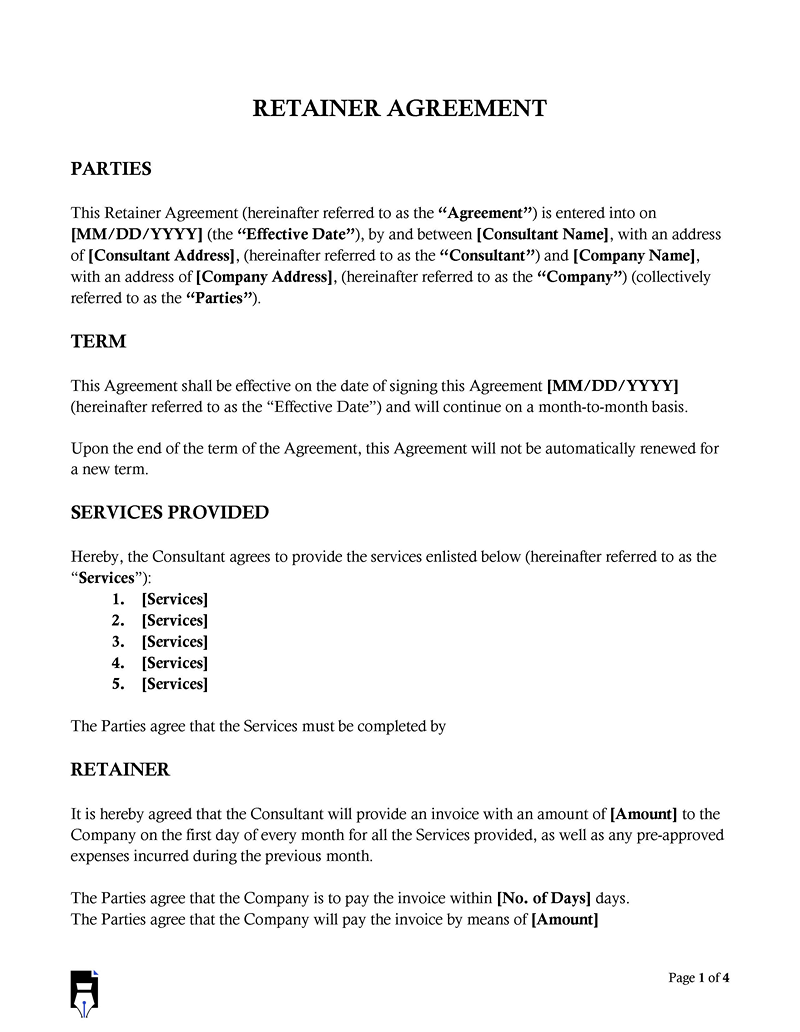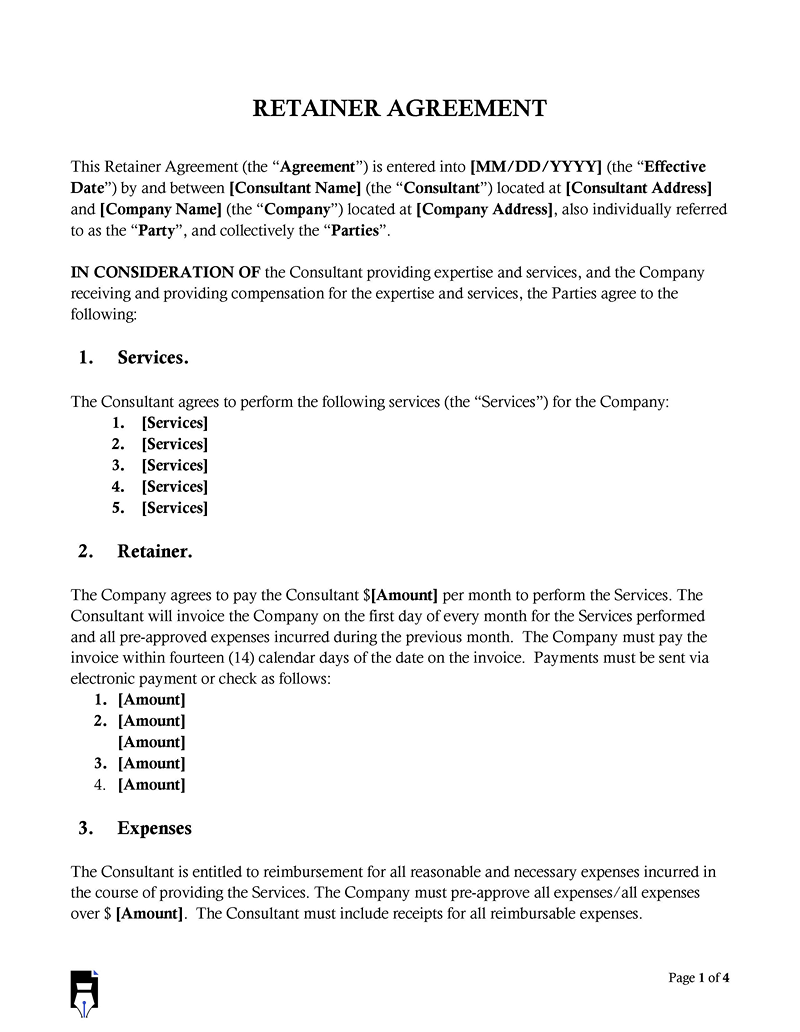A Retainer Agreement is a work-for-hire agreement that falls between a one-off contract and permanent employment, which may be full-time or part-time.
Unlike other pricing models, in retainer agreements, the customer must pay an advance retainer fee for professional work to be specified later. The primary purpose of paying the retainer fee is to ensure that the contractor/consulting business reserves time for the customer in the future when their services are required.
A retainer agreement may integrate other contractual provisions concerning the performance of services, or the involved parties may enter additional contracts that define the terms of their working relationship. The retainer fee can be payable on a fixed, pre-negotiated rate or a variable hourly rate contingent on the nature of the retainer and the contractor/professional being retained.
The utilization of retainer agreements is common among lawyers, accountants, copywriters, website managers, and business consulting agencies.
Types of Retainer Agreements
Generally, there are two forms of retainer agreements that freelancers, consultants, contractors, and attorneys can benefit from. They include:
Pay-for-work retainers
This is where a contractor provides ongoing work for a client and gets paid for the work done during that month.
Pay-for-access retainers/Monthly retainers
A pay-for-access retainer, alternatively known as a monthly retainer, is a fee paid in advance by clients to ensure that a contractor’s services will be available to them for the period covered.
Retainer Agreement Examples
Process of Signing a Retainer Agreement
Generally, there are no laws that require contractors and consultants to form retainer agreements with customers. Entering into such agreements is voluntary, and it simply depends on the involved parties’ preferences. However, if the parties decide to form a retainer agreement, they should draft a written contract for the agreement to enable them to make the various contract’s stipulations clear, including the payment amount, terms of use of the retainer fee, and remedies in case of legal conflicts. By signing a retainer agreement, both parties agree to enter into an enforceable contract under law. Therefore clients may need to be convinced of the professional’s expertise and technical know-how.
To talk a client into signing a retainer agreement, a contractor/consultant can consider the following procedural guide:
Negotiate the compensation
Setting up a retainer agreement begins with a customer reaching out to a contractor or professional seeking representation in exchange for payment. If the contractor agrees to represent the client, he/she will need to meet with the client to discuss the nature and full scope of the services needed. Both the involved parties will negotiate the hourly rate, contingency fee, retainer fee, and termination in the meeting.
Consider these valuable tips for negotiating a retainer agreement:
Target the most important clients
The best place to negotiate retainer agreements is among a contractor’s/professional’s most important clients. This will take time establishing the business, building a reputation, and proving value to the client. However, once the contractor establishes a solid base of one or two notable clients for whom they continuously work and deliver impactful results, it might be the right time to negotiate a retainer agreement with them.
Position yourself as invaluable to the client
A freelancer whose expertise is invaluable to a client can negotiate for a retainer agreement. Such clients are usually overtasked, under-resourced, and are in desperate need of help. As a result, they turn to the freelancer recurrently to help them out, and as projects add up, so do the billable hours. In such cases, one can negotiate a retainer with such clients and inform them how the pricing model can save them money and reassure them of dedicated service time whenever they need it.
Offer clients incentives such as a discount
Although some clients may opt to sign a retainer agreement with the contractor to secure their services, others will be hesitant to pre-pay before seeing the results. In such cases, offering a retainer discount may influence their decision to sign the retainer agreement. In essence, the contractor will still benefit from the commitment as they will be getting a fixed amount of work, earn a figure equivalent to their salary, and not have to spend money and time marketing their services to other clients.
Don’t skip the proposal part
Signing a retainer agreement is a big deal, and consultants should treat it as such by pitching their services with a well-thought-out proposal that focuses on the client’s needs and goals. The proposal must convince the client that the contractor’s knowledge and expertise will help make their life so much easier.
Ask for a contingency fee
To convince the client to agree to a retainer agreement, the contractor can negotiate a contingency fee with them. This tactic of negotiating retainers can be beneficial for professionals in the legal field or consulting firms. It is a fee for services paid upon successful completion of the task, and it is normally calculated as a percentage of the gain realized for the client.
Note: Contingency fee arrangements exclude costs and reimbursements, implying that the contractor may bill the client for costs and expenses incurred while solving the case, even when a case is unsuccessful.
Aim for a time-bound retainer
Now that the contractor has convinced the client to agree to sign a retainer agreement, it is time to get them to agree to sign a contract that is favorable to all the involved parties- a time-bound retainer agreement.
In most cases, retainers work best when signed for a longer period – usually 12 months. A 12-months retainer allows the consultant to determine what is valued most by the client, align expectations, and measure what true success means for everyone.
A contractor can benefit from highlighting goals and milestones in the retainer agreement to chart deliverables and progress during the contract period. For example, if a contractor is a freelance writer and the client is looking to publish 20 articles per month- the freelance writer can set a goal of delivering 8-10 articles per 7days in a month.
Note: Like any other time-bound contract, the consultant should include an exit strategy in the retainer agreement- in most cases, a 30 days’ notice plan. Including this strategy is essential because the client may decide to terminate the contract before its due time, and he/she will appreciate an easy exit strategy.
Choose the most suitable type of retainer
A contractor can choose from any of the following two types of retainer agreements based on the number of hours worked or access to knowledge and expertise. The retainer type that best suits a contractor depends on their relationship with the client and the client’s level of trust in the contractor and their expertise. The two types of retainers are as discussed below:
Pay-for-work retainers
The pay for work retainer model is where contractors provide ongoing work for their clients, and they, in turn, receive ongoing payment monthly. In this case, the contractor gets paid for hours worked during that month. This means that this type of retainer agreement is precisely the same as a contract or project, but it is different in that the contractor is required to provide and deliver work on an ongoing basis.
Pay-for-work retainer is typical among consultants at the initial stages of building business relationships with clients or slightly underway.
Pay-for-access retainers/Monthly retainers
The Pay-for access retainer, also known as the monthly retainer, is a pricing model that is usually leveraged by more experienced consultants and professionals. Unlike the pay-for-work retainer model, the pay-for-access model is rooted more in a professional’s insight and expertise. With this model, a consultant is generally not expected to work on deliverables or finish specific projects, but they are paid a retainer to offer the client advice on a specific field on an ongoing basis.
Generally, this model of retainer agreement is well suited for consultants who are either authorities in their industries or those that have previously worked for the client and proved to be a reliable and diligent worker for the customer.
The pay for access or monthly retainer is also common with clients seeking constant advice from consultants such as attorneys, accountants, and other professionals whose services are needed on a continued basis.
Be definite about the nature and scope of services offered under the retainer
Being specific about the scope of work under the retainer agreement can help mitigate scope creep. For example, if the contractor expects to get pulled in various directions by the client, they can use their retainer agreement to define and limit what these requests might be and use their expertise to gauge how many hours they’ll need to complete the work.
For instance, if the contractor is an attorney, there is a good chance that they will get emails, calls, and requests that extend beyond the scope signed up for in the retainer contract. Given such a case, the attorney can use the contract to define clearly what is and what is not included in the retainer and a standard hourly rate for anything that falls outside of the scope of work.
Note: Other crucial details to include in the retainer contract include the monthly fee, invoice date, payment due date, and how other expenses will be handled going forward. Moreover, the consultant can include details of how they’ll work with the client, their main point of contact, and the preferred meeting schedule. This can help the consultant to remain on track and deliver value work.
Carefully review the document
Before signing a retainer agreement, both the contractor/professional and the client should review the document, understand all its terms and revise the terms where necessary. Once a retainer agreement is signed by the parties involved, it means that they have agreed to all its terms, and it automatically becomes legally enforceable. Therefore, violating any of the terms outlined in the contract could have serious consequences to the involved parties.
Sign the retainer agreement
Once all the involved parties have read and understood the terms of the written retainer agreement and have agreed to its provisions, it is time to sign and officiate the contract. According to most states’ laws, only the contractor/professional and the client must sign the agreement. However, depending on the parties’ preferences, a witness such as a lawyer may be necessary when signing the agreement.
Get paid
Once the retainer agreement is signed, the client has agreed to pay an upfront retainer fee to reserve the services of the professional. In most cases, retainer agreements include clauses that read, “no work may begin until the client has fully settled the retainer fee.”
Thus, the client may be best served if they make the payment as soon as possible after the agreement is signed to get the case/work started.
Benefits of a Retainer Agreement
A retainer agreement details in writing the various obligations and expectations involved in a contract between a professional and a client, which may include ethical work principles, retainer fees, modes of communication, and professional ground rules. As such, the document can be beneficial to the contractor/professional for different reasons. These include:
Creating a guaranteed consistent income
Most attorneys, consultants, freelancers, and private contractors struggle with variable income. But when they set up a retainer agreement with the client, their services are retained for a particular timeframe- mainly many hours per month or per quarter. Thus, retainer agreements are a significant cash flow asset since the customer pays a pre-agreed amount for the consultant’s time and services each month.
Saving time and money trying to source new business
Signing several retainers with clients means that a consultant has enough hours guaranteed each month. This means that one will be able to focus more on the client’s work, and they will have the flexibility of spending less time and money trying to market their services to clients to get new business.
Improving relationships with clients
Retainers help streamline work processes for contractors, meaning that they can plan time better around particular clients, and in turn, better results are delivered. This helps improve business relationships with clients.
Retainer clients are easier to keep
Retainer agreements tend to boost trust between contractors and their clients. The whole idea of working for clients for a more extended period makes them realize that a contractor’s team is dependable, hard-working, and intelligent. Thus they would be more willing to secure services for the foreseeable future. This helps increase profits and predict cash flow without spreading resources too thin.
Drawbacks of Retainer Agreements
There are also some definite downsides to working on a retainer. They include:
Losing out better opportunities
Most contractors who successfully set up retainer agreements with clients tend to rely on them to support their business. Over-reliance on these clients may lead to the contractor losing out on better opportunities with other clients (the non-retailers). Moreover, if the retainer client decides to terminate the agreement before its expiration date- the contractor may suffer many losses.
Lack time to work for other clients
When contractors sign the retainer agreement, it means that they are locking themselves into a specific schedule. This has the potential of springing up conflicts due to inconsistent deadlines. Strict deadlines make it very hard for contractors to take on new jobs and run the risk of overextending their resources.
Less pay
Naturally, most retainer clients will agree to sign retainer agreements when offered an incentive such as a slight discount in exchange for purchasing services in bulk which may lead to the contractor cashing in less pay than they usually do with non-retainer clients.
Conclusion
As a service provider, it is crucial to have a formal written document that details both the involved parties’ expectations and obligations to ensure your business’s financial and legal protection. The clarity ensures better cooperation and communication as the work progresses. As such, a retainer agreement is a valuable document that freelancers should strive to sign with clients with whom they have worked for and built a reputable business relationship. The best form of the retainer agreement to sign with a client depends on the case, the parties involved, the necessary costs and obligations. Ultimately, the benefits of signing a retainer agreement with a client outweigh any downsides of working under such contracts.
